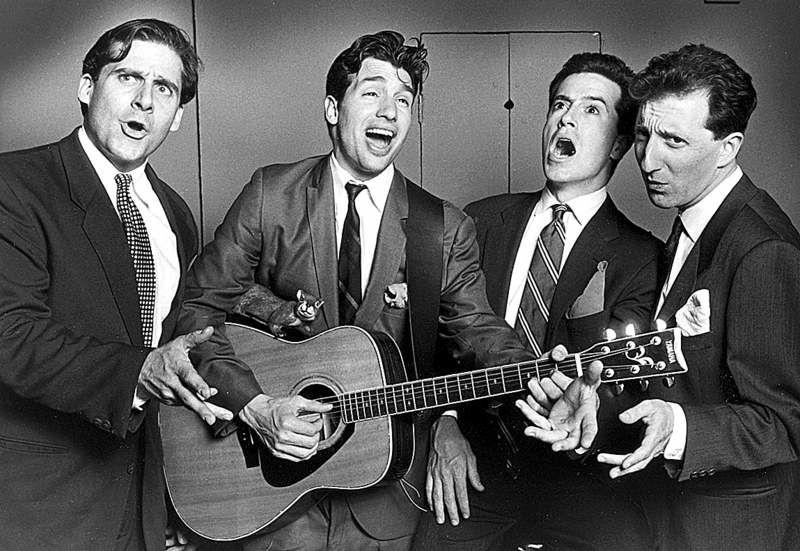Second City comedians have redefined funny
Published 4:00 am Thursday, December 17, 2009

- Steve Carell, from left, Paul Dinello, Stephen Colbert and Dave Razowsky, in 1993, are among the members of the Second City comedy troupe who have gone on to star in film and TV.
CHICAGO — On a frigid Wednesday night in December 1959, a revolution in comedy began here, almost unobserved. In a partly refurbished Chinese laundry in a bohemian neighborhood, a small improvisational troupe calling itself the Second City took to the stage for the first time to satirize the foibles of the Eisenhower era for an audience of barely 100, with a few bentwood chairs the only props.
Since that initial Dec. 16, millions have attended Second City shows or watched the troupe’s scores of alumni on television or in films. Second City is often likened variously to a comedy factory, farm team, finishing school or “Harvard of humor,” and its graduates include Alan Arkin and Joan Rivers from the early years, Bill Murray, Chris Farley and Mike Myers from later eras, and Tina Fey and Stephen Colbert more recently.
Second City commemorated its 50th anniversary over the weekend with shows, parties and panel discussions that, more than one performer said, “felt like a high school reunion.” Highlights will be broadcast as a TBS special in June and will soon be posted at the troupe’s Web site, www.secondcity.com.
But with the entertainment industry struggling to adapt to shifting tastes and new modes of expression, the gathering also served another purpose: to underline how the conception and execution of what is considered funny has changed, thanks to Second City.
At the time of the company’s birth, the dominant style in American comedy was stand-up, often with a strong dollop of borscht-belt shtick. From the start, Second City stood in contrast to that approach: It emphasized an ensemble, not the individual performer; improvisation rather than a written routine; sketches instead of jokes; and intellectual rather than slapstick humor.
“We came from the theater, and that affects the way you act, construct your scenes and think about your audience,” Bernard Sahlins, the only surviving founder of Second City, said in an interview on Friday.
Nowadays, a stint with Second City is often just a stage in a larger career strategy whose trajectory has been established by the example of all those successful alumni. A Second City credential can confer so much credibility that “some people lie about it” at auditions, said Tami Sagher, an alumna who has written for “30 Rock” on NBC and “Psych” on USA and appeared in “Curb Your Enthusiasm” on HBO and the film “Knocked Up.”
What transformed Second City into an institution with national reach was “Saturday Night Live.” The original cast included three Second City alumni — John Belushi, Dan Aykroyd and Gilda Radner — and ever since then, the company has been such a permanent pipeline for that NBC show, supplying about two dozen performers and even more writers, that staff members here recall Sahlins growing glum or irritated every time Lorne Michaels, the executive producer of “Saturday Night Live,” came to see a revue.
But in retrospect, several of those who trod the path to “SNL,” as the show is often called, seemed to prefer the work they did at Second City. At a panel discussion Rachel Dratch, who left the show in 2006, said she had “felt freer here” in Chicago; Tim Kazurinsky, an early-’80s cast member, said “SNL” seemed “a little bit toothless” by comparison; and Horatio Sanz (on the air from 1998 to 2007) lamented that “at ‘SNL’ you have to have the joke on the first page” of a script, whereas Second City allowed the performer-writer to “do what you wanted to do, to put in a 30-year-old reference and say, ‘Deal with it.’”
Second City’s 50th anniversary occurs at a moment when the company’s influence and prestige may be at a peak, even as television itself seems desperate to find new forms and approaches. Alumni of the troupe represent three of the most highly praised shows on the air right now: Steve Carell in “The Office,” Colbert on “The Colbert Report” and Fey on “30 Rock.”
The television show that probably most reflects a Second City sensibility, however, is “Curb Your Enthusiasm,” the Larry David series that has been nominated for 30 Emmys since 2000. Jeff Garlin and Shelley Berman, who play David’s manager and father, are products of the Second City system.
“‘Curb Your Enthusiasm’ could not exist without Second City,” Garlin said at a panel discussion on Sunday. That comedy series works from an outline, not a detailed script, to encourage improvisation. “It was always planned that way from the beginning, and that’s Second City,” he added.






